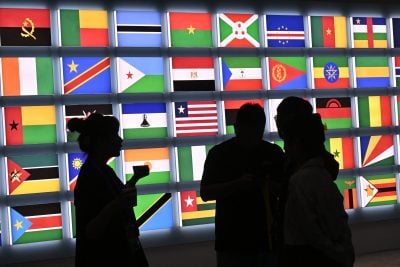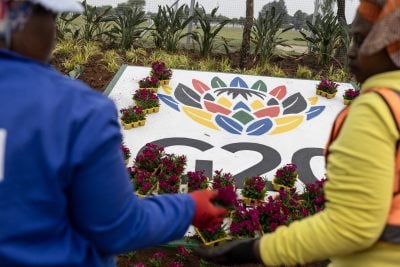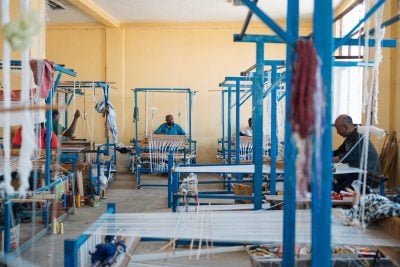As the first snow is forecast to fall on Washington DC in mid-December, 45 African heads of state will descend on the US capital for the second US-African Leaders Summit. The three-day summit, designed to ramp up trade and investment on the continent, has been hailed as a defining moment for US policy in the region.
Upon its announcement, US Vice-President Kamala Harris said the summit would showcase America’s “enduring commitment to Africa,” and would seek to address the barriers to trade, including “limited access to capital, the high cost of financing, and legal and regulatory bottlenecks”.
After years of rhetoric and global tumult, many hope that the summit will be a chance for America to put its money where its mouth is. But the summit takes place amid multiple challenges: a tough global economic climate; food and military insecurity in Africa; the rising toll of climate change; and declining exports under the US’s flagship African Growth and Opportunity Act (Agoa), which provides certain countries with tariff-free goods access to the US market.
Against this backdrop, some critics question whether substantive achievements will emerge from the summit. “This one is a geopolitical exercise, it’s a photo-op,” says Carlos Lopes, a visiting professor at the Nelson Mandela School of Public Governance of the University of Cape Town and former executive secretary of the United Nations Economic Commission for Africa.
The summit’s agenda centres on roundtables with African leaders, who will make pitches around specific topics in African affairs reminiscent of the TV series The Apprentice. Promises on climate change, ramping up market connections in Agoa, pledges to boost support in the continent’s battle against terrorism and appeals from Washington for heightened digital connectivity – all are likely to feature, he says. But Lopes is sceptical that the familiar conversations will prove game-changing.
“This was pre-determined in Washington and not through consultations,” says Lopes. “I think the summit is going to have a lot of these promises, but it’s not going to change anything structural.”
Progress
Still, after the disastrous African engagement during the presidency of Donald Trump, who failed to visit the continent once, the renewal of cordial relations represents a significant improvement in tone.
But the changes also go beyond rhetoric. In some areas, US policy towards the continent has been decidedly progressive. At the peak of the pandemic, the US government championed the continent’s battle against vaccine inequity by backing patent waivers that would have made it legal to manufacture generic versions of the vaccines. The European Union, the UK and Japan blocked these efforts.
The US also spearheaded efforts to push the World Bank and IMF to open up financial instruments to allow debt-strapped African nations to postpone their repayments under the Debt Service Suspension Initiative (DSSI). “In each of these developments the Europeans were behind the Americans, not ahead of the Americans,” says Lopes.
Trading woes
That said, trade, aid and investment have yet to see a meaningful uptick. Aid has kept a steady clip at around $13bn annually, but US exports to Africa have declined over the past decade and imports have plummeted due to changes in the pattern of US oil trade.
Under Biden, US exports of goods to the continent hit $26.7bn in 2021, down 30% from a high of $38.1bn in 2014, according to the US Department of Commerce.
As the US continues to pump shale in its decade-long quest for “energy security”, crude imports from the continent have dwindled by 26%, according to data from the US Census Bureau for US trade with Nigeria, Algeria. Ghana and Angola.
Two-way trade between the US and Africa hit $64.3bn in 2021 – barely 2% of US global commerce – down from a high of $141.9bn in 2008. This compares to a record $254bn in imports and exports between China and Africa last year. While the US is keen to outflank China in Africa, its attempts to encourage the continent as a major supplier of US goods and services appear to be faltering.
The tariff-free Agoa, the latest version of which expires in 2025, has helped to boost the goods trade between African countries and the US, but political disputes with African governments mean that the programme has been terminated for South Sudan, Ethiopia, Mali and Guinea, and the US plans to remove Burkina Faso from 1 January 2023. Experts say that the US should look at expanding Agoa’s remit to include services if the scheme is to have a more exciting future.
The resources sector is another area that requires an overhaul. While US firms are heavily involved in Africa’s hydrocarbons market, environmental imperatives mean that the world is increasingly turning away from fossil fuels. In the case of Africa, that is leading to the promotion of gas as a “transition fuel”. But the US has expressed scepticism that gas will be a long-term solution. In September, climate envoy John Kerry said that African gas projects may prove unviable after 2030.
“We do not have to rush to go backward, we need to be very careful about exactly how much we are going to deploy, how it is going to be paid for, over what period of time and how do you capture the emissions,” Kerry said.
Such comments may make US firms reluctant to invest. Still, if “transition” projects are off the table, Lopes says that the US could be much more active in pushing investors towards renewable energy projects in Africa.
“The real discussion is how you regulate [the energy sector] in such a way that you oblige the financial system to consider fossil fuels as a risk that they have to pay for, rather than protecting them. It’s not a coincidence that we still consider investments in renewables as in need of de-risking.”
Scaling ambition
There are clearly many potential areas for development, and with Biden having two more years left and being expected to run again in 2024 after a stronger-than-expected mid-term election performance, the summit could be the starting point for a more ambitious engagement.
The time is ripe for bold new initiatives, says Zem Negatu, Ethiopian-American chairman of the Virginia-based Fairfax Africa Fund. Grand projects have traditionally helped the US to cement deeper relations with its African partners. George Bush’s President’s Emergency Plan for AIDS Relief (PEPFAR) was the largest commitment by any nation to address a single disease in history.
“The big ‘re-imagining’ of the relationship I had expected hasn’t yet materialised,” Negatu observes. “Africa still gets little attention in Washington. I have yet to see any major US initiative which supports the continent’s economic development. Nothing to compare even to PEPFAR, Power Africa or the US Development Finance Corporation.” Barack Obama’s 2013 Power Africa strategy promised 60m new electricity connections across the continent along with 30,000 MW of new and cleaner power generation.
Distracted by the global economic crisis, the tail-end of the pandemic and climate change, Biden has yet to commit to a scheme of similar ambition in Africa. But there’s still time for Biden, says Negatu. “I will give the president the benefit of the doubt and hope he has something big to announce next month at the US-Africa summit. Let’s stay tuned.”
Want to continue reading? Subscribe today.
You've read all your free articles for this month! Subscribe now to enjoy full access to our content.
Digital Monthly
£8.00 / month
Receive full unlimited access to our articles, opinions, podcasts and more.
Digital Yearly
£70.00 / year
Our best value offer - save £26 and gain access to all of our digital content for an entire year!
 Sign in with Google
Sign in with Google 



